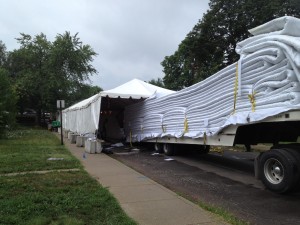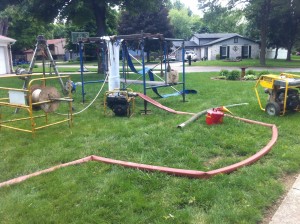November 2013, Vol. 68 No. 11
Features
Ongoing Rehab In Indianapolis

A major sewer rehabilitation program is under way in the city of Indianapolis addressing a backlog of structural repair and inflow and infiltration issues.
The program was initiated in 2011 when Citizens Energy Group (CEG) took over ownership and operation of the city’s water and sewer utilities from the Indianapolis Departments of Water and Public Works, respectively.
Before the changeover to CEG, city budgets had been tight and rehabilitation was often overlooked, said Roger Hanas, Citizens Water project manager.
“However,” said Hanas, “inspections and assessments of the sewer system were being made, so CEG inherited a well-understood system that had significant rehab needs. As a result, CEG made a decision to dedicate substantial funds towards rehab. Projections are we will spend $10 to $15 million per year for the foreseeable future.”
As the 2013 fiscal year ended, Hanas said 75,000 linear feet of pipe had been rehabilitated at a cost of $14.5 million. It was the first full year of rehabilitation since the program was started.
Of pipes rehabilitated, Hanas said there was significant deterioration on most of the large diameter, combined sewer lines. In some cases, large voids in the inverts and sidewalls of the pipe were present and large sinkholes in the road had formed over the pipes.
For the small diameter – pipes 18 inches and less in diameter – projects selected, the driver was inflow and infiltration (I&I) reduction.
“We had neighborhoods that were experiencing basement backups, and our CCTV investigation led to the conclusion that lining would help reduce the problem,” Hanas said. “Our initial conclusion is that the projects have been successful at reducing backups – none has occurred to date during significant rainfall events.”

MSAs
In order to maximize the amount of rehab that could be completed, CEG decided to enter into Master Service Agreements (MSAs) with three cured-in-place-pipe (CIPP) lining companies, said Hanas.
“MSAs eliminate both a lengthy design and bid process and allow for extremely efficient use of funds,” he pointed out.
The primary method of work completed has been CIPP rehabilitation.
“This method was selected in nearly every case, due to the MSA pricing structure and ability to complete work quickly, meaning minimal disruption to the customer,” explained Hanas. “Exceptions to CIPP were the use of shotcrete in certain situations, as well as an occasional point repair when major breaks were encountered.”
Shotcrete was the method of choice when the pipes had voids too large to bridge with CIPP which would prevent the bag from inverting properly or might expand into the voids, or when there were odd-shaped pipes that the lining companies could not accommodate.
“For example,” Hanas said, “there were ‘horseshoe’ shaped sewers with a concrete base and brick cap that were shotcreted because the lining company could not guarantee their liner would expand into the corners and adhere to the host pipe.”
Another technique used on a limited basis was the application of poly-based products to manholes that showed signs of hydrogen sulfide related deterioration.
“Poly products generally had not been used by the department of public works,” Hanas said, “but CEG sees value in poly products for targeted applications.”
Surface conditions of the year’s projects varied widely and most were not suited for open-cut construction.
“The large, combined sewers tended to be close to downtown and under well-developed and well-traveled roads,” Hanas said. “Buried manholes, bypass pumping and maintenance of traffic were major challenges of the large diameter projects. Our smaller diameter sewers were in neighborhoods and sometimes under easements in yards; so much more focus was placed on minimizing the project footprint and proper restoration of disturbed areas.”
Projects
Four projects illustrate the diversity of work completed during the year.
Fletcher Street Siphon – This was rehabilitation of a large, combined triple barrel siphon under eight lanes of Interstates 65 and 70 on the near east side of Indianapolis. The siphon consists of 24-inch ductile iron and 48- and 60-inch concrete barrels that convey sewage under approximately 500 feet of interstate highways.
“The Indiana Department of Transportation (INDOT) decided to conduct an emergency project to lower the pavement by approximately two feet after having a significant number of vehicles striking the overhead bridges due to height restrictions,” explained Hanas. “The cover over the siphon already was minimal – approximately six feet – and there was concern that construction activity above the siphon would cause it to break. CEG engaged Layne Inliner LLC to complete CIPP rehab of the siphon barrels prior to INDOT commencing work on its project.”

Work was completed in one month at a cost of $800,000. “The project became extremely challenging once it was discovered that the field conditions differed greatly from the siphon as-builts,” Hanas said. “The approach shafts were not built at a 45-degree angle as shown on the as-builts, but were nearly vertical. This required quick and creative thinking, as the contractor could not line the vertical portions of the shaft due to fear of resin migration. We settled on lining the horizontal portion of the siphon and spraying a poly product on the vertical sections.”
Warman and Sugar Grove LDSR – Several segments required new inverts. Insituform Technologies USA and Layne Inliner performed large-diameter lining of combined sewers near downtown. In several cases, large sections of inverts were badly broken or completely gone.
“These areas subsequently had developed large, deep holes and were not repairable with traditional CIPP methods,” Hanas explained. “National Granite, a shotcrete subcontractor, was brought in to hand clean and pour new inverts in the pipes. Once the shotcrete repairs were made, a CIPP liner was inverted to complete the repair. We have had to perform these types of hybrid repairs to over 2,500 linear feet of sewers. We paid an average of $100 per foot for shotcrete repairs – about $250,000 – to make the segments lineable via CIPP.”
Boulevard and 26th Street 72-Inch Combined Sewer – Contractor Layne Inliner was responsible for lining 2,000 linear feet of combined sewer for this segment, but because the company’s wet-out facility was several hours away, it was apparent trucking liner to the site was not a viable option. The alternative selected was over-the-hole type inversion.
“This required construction of a large, on-site wet-out facility that remained in operation 24/7 for a week until the project was completed,” said Hanas. “A challenging aspect of the project was maintenance of laterals since an over-the-hole inversion does not allow for lateral re-instatement as work proceeds. Therefore, we chose to install clean outs at each home on the line and station a vacuum truck on site to clean the laterals daily.”
Cost of this segment was $1 million.
Brouse Avenue UV-Cured CIPP – Brouse Avenue runs through a 1940s-era neighborhood where the sewer system consisted of old vitrified clay pipe that was severely deteriorated. Residents were complaining of poor sanitary service and investigations found a system in need of CIPP rehabilitation.
“Layne Inliner approached CEG about the possibility of piloting UV-cured CIPP liners in this area, as the company had just constructed a large UV wet-out facility at its plant, Hanas said. “CEG was interested in testing the product for several reasons, and of primary interest was the claim that the styrene odor that sometimes causes complaints would be virtually eliminated by styrene barriers constructed into the tubes.
Approximately 3,500 linear feet of CIPP was installed into the 10-inch host pipe and complaints about sanitary service have been eliminated. Cost of the segment was $180,000.
Miller Pipeline also holds a master contract for lines 18 inches in diameter and smaller but to date no project in that category has been done.
Citizens Energy Group is a public charitable trust that has served Indianapolis for nearly 125 years and has provided gas services to more than 266,000 customers in Indianapolis and Marion County since 1887. Its combined water and sanitary sewer infrastructures cover approximately 320 square miles and in addition to Indianapolis, Citizens also provides services on a wholesale basis to the cities of Beech Grove, Lawrence and Greenwood, the Ben Davis Conservancy District and three outside-the-county development areas.
Citizens also operates the second largest steam and chilled water distribution system in the U.S., providing heating and cooling to large commercial, industrial and institutional customers in downtown Indianapolis.
FOR MORE INFO:
Layne Inliner, (812) 723-0704, www.layne.com
Insituform, (800) 234-2992, www.insituform.com
Miller Pipeline Corp., (800) 428-3742, www.millerpipeline.com




Comments